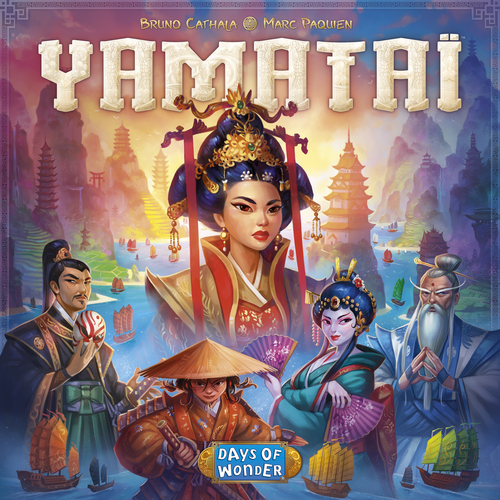“A lifetime of low calories has come naturally to the longest-lived people in the world… in the Japanese archipelago of Okinawa.”
~ S. Jay Olshansky
In Yamatai, players compete to build palaces, torii, and their own buildings in the land of Yamatai.
Let’s start with the comparison to Five Tribes… THEY’RE VERY DIFFERENT GAMES! Same designer, same publisher and both very pretty, but that’s it. Done.
Now let’s look in the Yamatai box, it has an insert that holds everythi… agh what happened!

Keep the box flat people! I did put the punch boards under the insert tray to see if it helped, and it did.
Anyway, a game lasts 5 phases, each shown on your player board.

Boat Tiles
The first is to take a Boat Tile. These tiles tell you which Wooden Boat Resources to take from the supply. Each tile also has a different ability for you to use this turn.
The boats also have numbers representing your position in turn order for the next round.

You take your chosen Boat Tile from the 5 available. Take the boats from the supply as shown on that tile.
Buy or Sell a Boat
The second action in a turn is to either buy or sell one boat based on the price on your player card.
Place Boats
The third is to place boats on the board…

The first boat you place must be in a designated start space or next to a boat of the same colour on the board already. The rest must be in a chain connected to each other creating a path around the watery parts of the map.
Once this is done you can now build a building if able. There is a selection of buildings next to the board and if the right combination of resources is around an island, and the island is empty, you can build on that island.

Or, you can take a number of tokens from islands you placed boats next to, these can be used to hire Specialists if you didn’t build which I will mention later.
Store a Boat
The fourth phase of a turn is to store a boat. You can keep one boat in your Dock from turn to turn and any additional unused boats go into a different area of your board and work towards giving you minus points at the end of the game.
The fifth and final phase is to spend those tokens you can collect from islands to hire a Specialist. These give you abilities you can use throughout the game and I forgot to take a picture so sorry about that!
Once everyone has taken their turn, the Boat tiles are moved up on the board, the first 5 are turned up as the new selection for the next round of the game. The ones used this turn are shuffled and placed face down at the end of the queue.

After one of many endgame conditions are triggered in Yamatai, players score for coins, prestige tokens, buildings and specialists. Points are lost for reserved buildings and unused boats.
Most points win.
Yamatai Positives
The first phase, the turn order mechanism, is great. You’re picking which boats you get, a special ability for the turn and your turn order for the next round. The one tile gives you 1 resource but you go first next round, the ten will give you 3 resources but you’ll go last. The tiles shuffle around every turn so the picks are different.
The abilities on the Boat Tiles are varied allowing you to switch boats, reserve buildings, build at a discount etc
The specialists are also varied and not all of them will be available for each game in most cases so there is a bit of variety there.
Yamatai Negatives
Phase 2-5, the meat of the game, is pretty uneventful and quite dull.
Lots of different symbols on the boats and specialists mean a lot of rulebook referencing.
Worth mentioning again that phase 2-5 in the game is poor.
At the end of the game, no one felt anything.
Summary
It’s only ‘OK, which is nowhere good enough when fighting for time with other games to want to play this again.



Leave a Reply